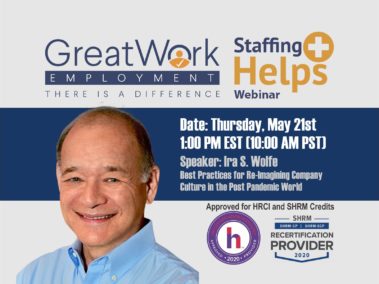Welcome back. To learn more about managing through our new normal, join us on Thursday, May 21st at 1:00 EST/10:00 PST for a live webinar with Ira on “Re-Imagining Company Culture in the Post-Pandemic World.” Register now.
This event has been pre-approved for both SHRM and HRCI credits.
This is a guest post by Ira S Wolfe, the founder and president of Success Performance Solutions, a celebrated thought leader in the future of work and HR, and best-selling author of Recruiting in the Age of Googlization.
 Re-boarding Your Business and Your Employees
Re-boarding Your Business and Your Employees
There is light at the end of the tunnel. At some point, the pandemic will end. Organizations and people will attempt to thrust themselves back into something approximating normal. However, expecting normalcy to return without issue invites a second crisis—one that also happens to be preventable.
From a loss of income to the loss of a loved one, the COVID-19 pandemic is taking a serious toll on everyone—from working-level to the C-suite. Feeling anxious, confused, overwhelmed or powerless is common during an infectious disease outbreak. As society attempts to cope with reality, millions of people are experiencing changes in sleep and eating patterns, difficulty concentrating and the exasperation of mental health problems. Expecting the stress to just blow over after the shelter-in-place orders are lifted may place your employees and business in harm’s way again.
Now is the time for leaders to act. Getting the response right might define your career—and serve as your organization’s defining moment.
Here are a few steps you can take right now to post-pandemic-proof your business.
-
Do not expect getting “back to normal” will be anything close to normal.
“Back to normal” implies the possibility of going back to exactly the way things were. In the case of this pandemic, that is not only misleading but potentially dangerous. The disruption and consequences caused by COVID-19 and the response to it are unprecedented. This novel coronavirus viciously exposed our personal, corporate and governmental vulnerabilities. Every country and human on this planet has been impacted in one way or another.
Tip: Adopt a “re-build” rather than “resume” attitude. Life was not just put on hold when the crisis hit. Humans don’t have a pause or rewind button. Regardless of how each of us has-beens affected and responded, we are different now. Life is different now. Uncertainty and ambiguity aren’t going away. It’s okay to be uncomfortable as we adapt to an evolving “new normal.”
-
Anticipate that the return to normalcy could take 12 to 18 months.
Much to the dismay of billions of people, COVID-19 likely isn’t going away. It’s a virus, not a blizzard or earthquake. Unlike natural disasters that have a beginning and an end, this catastrophic event will be mitigated, but it won’t disappear. It’s likely to linger, and even reappear, if we don’t remain vigilant. It took more than three millennia to eradicate smallpox. Thanks to modern medicine and technology, it’s reasonable to expect the “cure” for COVID-19 might only take years.
Tip: Physical distancing guidelines will need to be practiced for months ahead—especially in the workplace. Personal protection equipment (masks and gloves) will need to be provided for both physical safety and emotional peace of mind. Anticipate how CDC guidelines might affect production work, customer interaction, and travel. Embrace remote work whenever possible. Discuss how and when meetings and gatherings will be conducted, including networking and lunchroom gatherings.
-
“Reboard” your employees.
Welcome back each employee like it’s the first time you’ve met them. The novel coronavirus has undone a century’s worth of habits in just a few weeks. There will be personal and economic consequences. A lot of workers will return to their jobs as different and, in many cases, more vulnerable people.
Tip: Schedule one-on-ones with each employee. We are all responding to this crisis differently. Some of us are stressed about older parents living alone. Others are concerned about the safety and education of young children. Some are still cashing paychecks, while others are standing in food lines. Conversations should address the unique challenges faced by each employee. Many of these meetings can, and should, be done in advance to get a pulse on levels of engagement or challenges that lie ahead. You should be reaching out to workers regularly, anyway—furloughed or not!
-
Train your managers and supervisors to recognize the invisible signs of trauma.
I’m not suggesting your non-clinical staff learn to diagnose. But it is important to help them simply become aware of symptoms. Some managers have great relationships with their direct reports. They’ll know in a heartbeat who has weathered the crisis well and who hasn’t. Unfortunately, many don’t. They won’t have a clue (without some training) who is adjusting well and who isn’t.
Tip: Make sure every manager and supervisor is able to recognize the signs and symptoms of emotional trauma, post-traumatic stress (PTS), and even post-traumatic stress disorder (PTSD). There are a number of organizations in your community ready to help. Many offer on-site training and evaluation. Some offer free online resources and e-learning courses.
-
Upskill your leaders.
Many leaders entered this moment unprepared; few are ready for what’s next. Many managers were elevated into their roles based on their technical prowess or tenure. This isn’t the time to have them make it up as they go. Further, front-line supervisors, in particular, directly manage 80% of the workforce and, odds are, most lack the soft skills needed to help their teams navigate what lies ahead. You can’t afford to send them into this “battle” without the proper tools.
Tip: There is no time like the present to invest in your managers. Enroll your front-line supervisors in online learning courses on coaching, active listening, communication, leadership and stress management. Grow their emotional intelligence and team-building skills. If there ever was a time for empathy, trust and compassionate communication, it’s now.
The notion of life as a linear journey ended weeks ago. We’re now living, working and growing on an exponential curve. Hop on board. You’ve got a one-way ticket, and your next stop has yet to be determined. Consequently, there is no getting back to business as usual. The best advice: Prepare for business as unusual.

